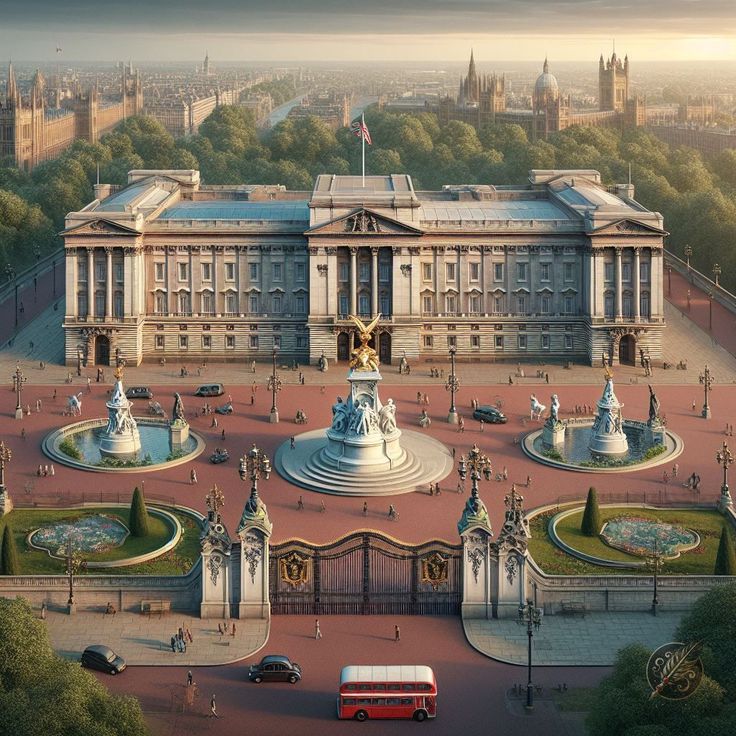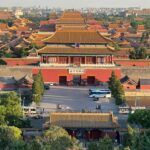Buckingham Palace, United Kingdom: The Heart of the British Monarchy
Buckingham Palace is not only the official residence of the British monarch, but it is also a living symbol of the British monarchy, history, and tradition. Located in the heart of London, Buckingham Palace has served as the residence of the royal family for over 180 years, standing as one of the most iconic landmarks in the world. Its grand architecture, royal significance, and rich history make it a place of fascination for tourists, history enthusiasts, and royal watchers alike.
History of Buckingham Palace
Originally known as Buckingham House, this grand building was acquired by King George III in 1761 as a private residence for Queen Charlotte. In 1826, King George IV initiated plans to expand and renovate the house, transforming it into a larger palace. The project was completed under the reign of Queen Victoria, and the building officially became the residence of the monarch in 1837 when she ascended to the throne.
Since then, Buckingham Palace has served as the official London residence of the British royal family. The palace is not only the home of the reigning monarch but also functions as the administrative center of the monarchy, where royal duties are carried out, and ceremonial events take place.
Architectural Design and Features
Buckingham Palace is renowned for its grand architecture and impressive design. Several renowned architects, including John Nash, Edward Blore, and James Pennethorne, contributed to its development over the years. The palace’s architecture reflects neoclassical principles, with a blend of elegance and grandeur. Some of the most striking features of Buckingham Palace include:
- The Victoria Memorial: Located in front of the palace, the Victoria Memorial is a statue dedicated to Queen Victoria, who reigned for 63 years. This iconic monument, designed by Sir Thomas Brock, stands as a tribute to the longest-reigning British monarch at the time and serves as a focal point of the palace’s surroundings.
- The Balcony: Perhaps one of the most famous features of the palace is its iconic balcony, which is frequently seen during major royal events, such as royal weddings, celebrations, and state occasions. Members of the royal family often appear on the balcony to greet the public and share important moments with the nation.
- The State Rooms: The State Rooms of Buckingham Palace are used for official functions, including state banquets, meetings with foreign dignitaries, and ceremonial events. These rooms are exquisitely decorated with fine art, luxurious furnishings, and antique pieces, showcasing the opulence and history of the royal family.
- The Royal Mews: The Royal Mews is the area of the palace that houses the royal collection of carriages, coaches, and horses. The Golden State Coach, used for the coronation of monarchs, is one of the most famous pieces in the collection. The Royal Mews is open to the public, offering visitors a glimpse into the regal transportation used by the monarchy.
- The Gardens: The palace’s gardens cover over 40 acres and are among the largest private gardens in London. They are home to a wide variety of plants, trees, and wildlife, including swans and ducks that can be seen in the palace’s large lake. The gardens also host royal events, including summer garden parties.
Significance of Buckingham Palace
Buckingham Palace holds profound significance in British society, culture, and governance. It is not only the official residence of the monarch but also a symbol of the stability and continuity of the British monarchy. Here are some key aspects of its significance:
- The Official Residence: Buckingham Palace serves as the official residence and working headquarters of the British monarch. While the Queen or King may have multiple residences across the country, the palace is the primary home where official duties are carried out, and royal functions are hosted.
- Political and Ceremonial Center: The palace is the center of many state occasions and political functions, including state banquets, investitures, and the changing of the guard ceremony. These events play a key role in the life of the royal family, maintaining diplomatic relations and the traditions of the British monarchy.
- The Changing of the Guard: One of the most popular traditions at Buckingham Palace is the Changing of the Guard ceremony. This ceremonial event involves the official handover of responsibility for guarding the palace from one group of soldiers to another, and it is a major attraction for tourists from around the world.
- Symbol of National Unity: Buckingham Palace also represents the unity of the United Kingdom and its Commonwealth nations. During times of national celebration or crisis, the palace serves as a focal point for the nation’s emotions, with the royal family offering support and leadership during important events.
- A Cultural Icon: Buckingham Palace is a major cultural icon and one of London’s most visited landmarks. Tourists flock to the palace to catch a glimpse of royal life, explore its history, and witness the rich heritage of the British monarchy.
Key Facts About Buckingham Palace
- Location and Size: Buckingham Palace is located in Westminster, London, covering an area of around 40 acres. The palace contains over 700 rooms, including 19 state rooms, 52 bedrooms, and 188 staff rooms.
- The Royal Family’s Living Quarters: While the State Rooms are open to the public, the monarch’s living quarters are private and not accessible to visitors. The royal family resides in the palace during certain times of the year, including during the summer months when they may move to other royal residences, such as Windsor Castle.
- Changing of the Guard: The Changing of the Guard ceremony at Buckingham Palace is one of the most famous traditions in Britain. It takes place daily during the summer months and every other day in the winter, offering a colorful spectacle of British military pageantry.
- The Palace as a Museum: During the summer months, Buckingham Palace opens its doors to the public, allowing visitors to explore the State Rooms, view art collections, and learn about the palace’s history. The palace’s art collection includes works by renowned artists like Rembrandt, Vermeer, and Canaletto.
- Role in Royal Weddings: Buckingham Palace has been the site of several historic royal weddings, including the weddings of Princess Diana and Prince Charles, and Prince William and Catherine Middleton. The palace balcony is a key feature during these moments, as the newlywed couple appears to greet the public.
- The Queen’s Garden Parties: One of the most significant social events held at Buckingham Palace is the Royal Garden Party, hosted by the Queen. These events bring together dignitaries, celebrities, and public servants to celebrate achievements and contributions to society.
- Flag Tradition: The palace is easily recognizable by the Royal Standard, the flag that flies above it when the monarch is in residence. If the Queen or King is not at the palace, the Union Jack flies instead.
Impact on Society and Tourism
Buckingham Palace is not just a residence; it is a living symbol of the United Kingdom’s rich history and traditions. Its role as the official home of the monarch makes it a vital part of the country’s political and cultural landscape. The palace draws millions of visitors each year, contributing to the UK’s tourism industry and helping to maintain the global prominence of the British monarchy.
As a symbol of national identity, Buckingham Palace represents the monarchy’s role in uniting the people of the United Kingdom and the Commonwealth, while also acting as a point of pride and continuity through the ages.
Conclusion: A Timeless Symbol of Royal Grandeur
Buckingham Palace stands as one of the most important and recognizable buildings in the world. From its regal architecture to its significance as the center of royal life, it remains a lasting symbol of the British monarchy’s rich history, continuity, and global influence. Whether you are visiting for a state function, attending a garden party, or simply exploring its majestic rooms, Buckingham Palace offers a glimpse into the heart of British royal life.










